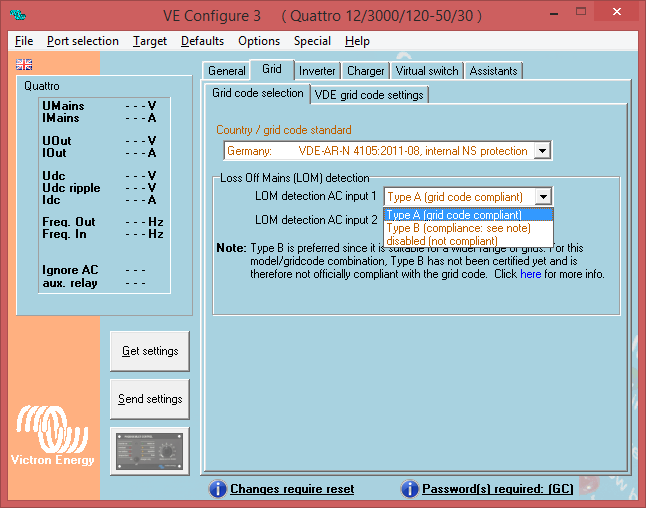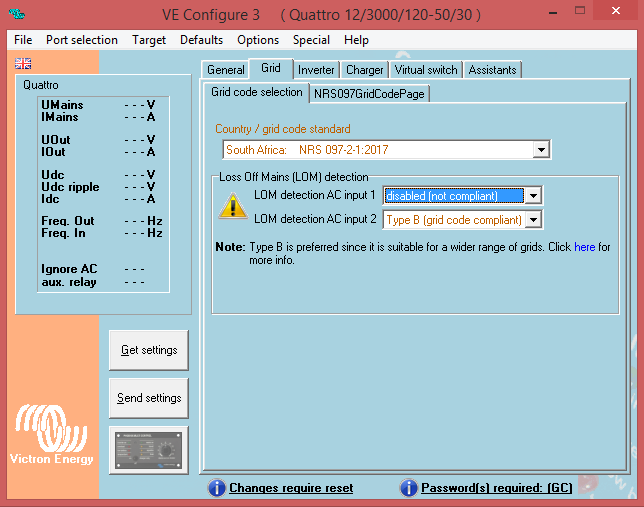This is an old revision of the document!
Table of Contents
VEConfigure: grid codes & loss of mains detection
This document applies to VE.Bus firmware 419 and later.
1. Grid codes and complying to local regulations
All countries have their own legislation and therewith their own requirements with regards to the speed of Loss of mains detection, under & over voltages, accepted ramp times, and so forth. To make an installation comply to local regulations, the correct grid-code needs to be selected.
The exact requirements differ widely between the countries. For example the normal Multis, Quattros and MultiCompacts are certified for use in the UK. For other countries, Germany for example, only the MultiGrid is and can be certified to be used without having to add more external anti-islanding safety devices (ENS). And in yet other countries an external ENS is required and/or the inverter/charger must be configured with the right grid-code. Check the safety certificates on our website to see the allowed models for your country.
2. Loss of mains detection (LOM)
What is LOM detection?
LOM is an automatic process that detects a change and so loss of the mains/network/grid supply. After the detection, the inverter/charger will open its back-feed relay, making sure there is no live AC voltage on its AC-inputs, and anything connected to these inputs.
Why is LOM detection required?
The purpose of LOM is to detect that the Multi is no longer connected to the mains. Be that a generator or the grid. In such case, the Multi needs to open its back-feed relay. Not doing that would be unsafe. Imagine an electrician working on the street, and disconnecting a house. He then needs to be able to safely work on the wiring from the house.
How does LOM detection relate to overload shutdowns?
To detect a loss of mains, the inverter/charger will constantly try to shift the AC frequency. When connected to a stable grid, with a normal accepted impedance, it will not be possible to do so, and it can therefor detect that the mains is still present. In case the mains was lost, the inverter/charger will be able to shift the frequency at will, without any resulting correction currents.
When connected to a generator, or to a grid with a long extension cable or long ‘last mile’ cable, the pushing and pulling on the grid does create high currents, and as a result the inverter/charger algorithm can become unstable and switch itself off in overload.
LOM detection Type A and Type B
LOM detection comes in two flavours: Type A and Type B.
Type A is the strongest form of LOM detection resulting in the quickest detection time. It requires a low impedance connection to the grid (short, well sized cables). LOM Type A will not work with generators.
Type B has a more soft approach and a slightly longer detection time. Type B has been type tested and approved for most Multi/gridcode combinations. (The only combination not tested so-far is MultiPlus/Quattro i.c.w. UK grid code. However this combination is most likely valid. It has just not been type tested yet.)
On generators, and also with installations having a relatively high impedance mains connection, Type B will work better than Type A.
For generators on which also Type B does not work, see Disabling LOM.
Disabling LOM
Besides choosing Type A and B, it is also possible to disable the LOM entirely. Note disabling the LOM on an input connected to the grid is only allowed when other external safety equipment is installed.
Disabling the LOM on an input connected to generator can be done, but then other methods / warning signs must be provided. Ensuring that any installer that will work on the generator will make sure to also switch off or otherwise disconnect the Inverter/charger system.
Grid codes and Type A and Type B LOM
Some Grid codes will use Type A and others will use Type B. The Type that has been tested and approved for compliancy is marked with grid code compliant. See below screenshot.
- Grid codes using Type A: VEConfigure lets you override that to Type B and/or disabling LOM.
- Grid codes using Type B: VEConfigure lets the installer override it to disabling LOM only.
3. Example configuration in VEConfigure
- A generator that requires LOM to be disabled.
- Generator on AC in 1, and grid on AC in 2, as recommended.
4. Questions
Q1: Where can I get the password?
A: From your dealer.
Q2: Can I use ESS in a vehicle or a boat?
A: No you cannot. After unplugging the shore cord it can take up to a few seconds for the system to detect the loss of mains and open the back-feed relay. During those seconds, the shore power plug will be `live`: there is 230 Volts AC on the terminals. The exact number of seconds differs per country and depends on the local requirements.
The same applies to other solution where the wiring is not protected against accidental removing, for example a simple cable with end-user removable plug, such as a portable power supply.
Q3: Can I use ESS with a generator?
A: Yes you can. Note that the only installation type where that makes sense is a land based installation (no boat, and no vehicle). A Quattro must be used with AC input 1 connected to the generator, and AC input 2 connected to the grid. The role of the generator will be to provide power during a long grid failure.
Some, bigger or better quality generators, will be able to work with LOM Type B. For other less stable generators it will be required to disable LOM entirely. In that case make the installation such that it is still safe: no simple extensions cords, use enclosed wiring cabinets with warnings on the outside and/or an external ENS.
More information here: https://www.victronenergy.com/live/multiplus_faq
Q4: I use ESS, but have disabled feed-back, is a grid-code still required?
A: Yes, also in this case LOM is required to make for a safe and also local regulations compliant system. Running ESS with disabled-feed-back is still not the same as using a Multi in its default configuration without ESS.
 Add this page to your book
Add this page to your book  Remove this page from your book
Remove this page from your book  Manage book (
Manage book ( Help
Help 
